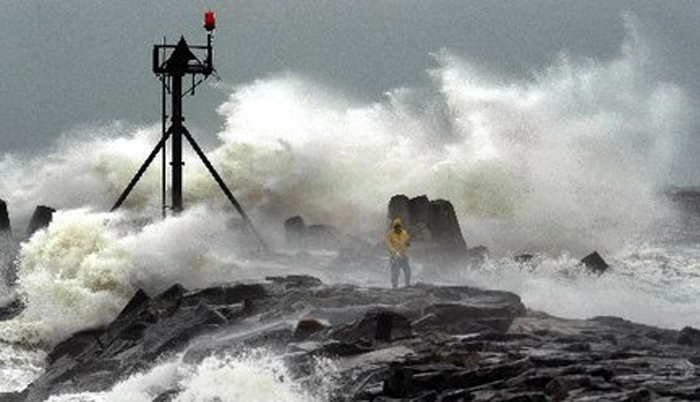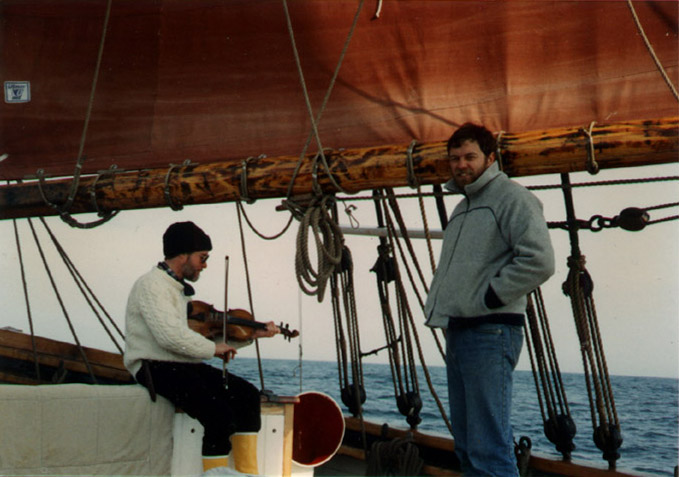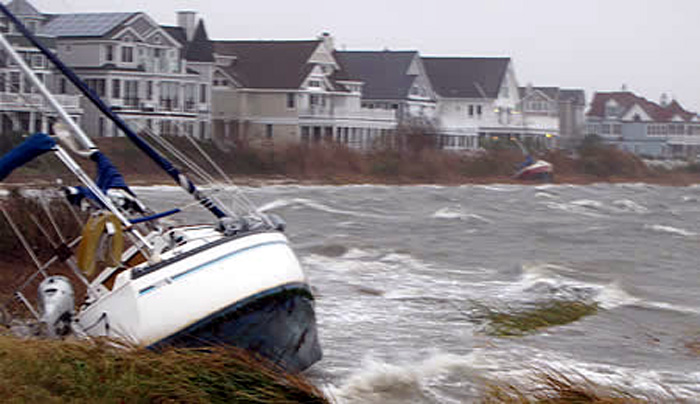|

Storm surge rages over
point at Cape May in recent Northeaster (Andrew Mills, The Star
Ledger).
By John
Townley
I
was raised as an only child aboard the
56-foot
motor-sailor Escape,
home-schooled,
and one spring in the early 1950s while sailing northward off Cape May
we ran
into a serious gale and began taking green water over the bow. As a
child, I
thought this an enormously fun adventure, and never noticed my mother's
white
knuckles clinging to the rails as she lashed me down in the cockpit,
fearing
for our lives. Trusting our Graymarine diesel to push us through, I
expect my
parents' outlook changed distinctly for the worse when the steering pin
broke
while trying to make port, leaving us wallowing helpless in the storm.
My dad
set the jib to keep her into the wind and then, naturally, discovered
we had no
replacement cotter pin. Davey Jones loomed. All too classically, as if
in a
movie, my mom actually produced a hairpin and my dad used it to fix the
problem, just in time to make the dreadful right angle of the channel
between
breaking shoals into Cape May. After a few more close calls with
hurricanes and
being stranded high and dry in the Bahamas, my parents swallowed the
anchor and
we moved ashore.

#1: 56-foot
motorsailor Escape
escaped foundering, despite broken steering pin...
But this
was to be only the first
time
I was delivered from
the jaws of death at exactly this spot. Many years later, in 1989, I
found
myself crewing aboard the 125-ft Baltic schooner Alexandria
(nee Lindo)on
her way to Maine in January to get her rotten stem repaired (the yards
gave a
discount in this unlikely time of year). As we headed out of the
Delaware River
and into the Atlantic, it happened again.
My
journal the morning after
describes
it first-hand:
Jan
28 (8:30
AM) – What a peaceful postlude to a tumultuous night! I
turned in
at 9:30 and
woke at 1:30 to a heavy swell, indicating we had entered the Atlantic,
tried to
go back to sleep. At
2:30 heard the
bilge alarm go off and just about as I was ready to go find out if
someone was
doing something about it, it went off & the pump cut in, so I
rolled over
once more. Finally, at 3, I was awakened from a dubious embrace by a
series of
crashes, so jumped out of my bunk & into my boots and upon
opening
the door
found the hall awash and a large jar of preserves in shards. The rest
of the
crew was turning out in sock feet so I first went to clean up the glass
before
it took out a hand or two. The ship was thrashing about madly and the
main
cabin was awash as well. Donned my oilskins and arrived on deck where
the Capt.
had ordered the foresail raised to steady her – a wonderful
study
in men racing
around in the dark by flashlight and in only a minute or two had the
saill raised
and the boom braced to the stays with a preventer tackle to steady it.
I
secured
the foresheet and was sent to the helm where I remained for the next 4
½ hours,
taking over from B.

#2:
Baltic Schooner Alexandria
in better days...
While I
was
still trying to stow flying objects below, there was a magically uneasy
moment
when everyone was trying to figure just what was going on, the crew
from the
forecastle having just been literally washed out of their bunks. Then
everyone
went into action to remedy the situation, half on deck to get sail
going, half
to figure out the pump situation. Apparently, the engine pump had
failed and
then the main pump had clogged, which made it seem like the bilge was
being
drained when it wasn’t (the ship is in a very leaky condition
right now, one of
the repairs she is scheduled for).
A third
gasoline deck pump was rigged, which helped, and the manual pump was
manned –
which had been rusted frozen for ages and only yesterday George decided
it
should be put back in action, if only for a shanty or two! Meanwhile we
altered
course due East straight out to sea to get into deeper water where the
swells
would be longer and not toss the ship about so crazily. So we proceeded
entirely under sail for a while, the engine being used entirely for
powering
the pump, apparently in good enough working order now to keep the
engine room
from flooding. Steering was a little dodgy with the wind and swell
strong on
the starboard quarter, but not a serious problem (wind 15-20, swell
about 3
feet – not bad, just at exactly the wrong pace &
direction).
At no time did
I ever feel really in danger, just that necessary measures need to be
taken
expeditiously. Not so for a trawler I heard on the radio while at the
helm –
she also had bilge pumps out with no backup and the Coast Guard was
racing to
rescue her.

Author fiddles as
Capt.
Leigh Ross walks the deck of Alexandria,
after his swift actions saved her...(photo: George Salley)
The Grim
Reaper was foiled again,
Davey Jones delayed. And I was in much greater danger than my journal's
bravado suggested or I even knew. Alexandria
was later to
sink
off Cape Hatteras of almost identical causes, fortunately without me on
board.
Finally,
only a couple of years
later,
I crewed with the
same captain (Leigh Ross) taking a little, brand-new 29-foot sloop from
Annapolis to Mystic on what turned out to be a multiple-disaster ridden
voyage.
Our troubles began as we were headed out at night underneath the
Chesapeak Bay
Bridge-Tunnel with captain, mate and owner all beyond functioning from
seasickness,
leaving me to singlehand her into a light headwind through a dense fog
and
rising seas. Fortunately (I believed for the moment) she was an
all-electric
vessel with an automatic pilot which held course while I handled the
lines,
tacking back and forth in the narrow channel between shoals ominously
marked
"Unexploded Ordinance" and dodging incoming container ships. It was
an adventure, until the batteries gave out and everything on the boat
stopped
working - no engine, no automatic pilot, even the electric head went
out. It
was all I could do at three in the morning to turn her around and sail
wing-and-wing back into Norfolk harbor.
A
day later, with new batteries
installed, we were happily
cruising farther up the coast when the head blew up - the wonderful
electric
device had overpumped the holding tank, blown out the valves and hoses,
and you
can imagine the rest. There is nothing like being in close quarters
with three
other people all covered in raw sewage. There is truly no place to run.
It took
the rest of the day to
clean
up, make repairs, and
finally recover at least in part from the smell, and the following
afternoon
found us in better spirits off Cape May in a brisk, changeable wind out
of the
west (20-30 knots) on a choppy sea surrounded by spotty thundershowers
mixed
with sunshine. It really did seem like fairly harmless weather - small
craft
warnings, for sure, but ideal for a racing skipper. Captain Ross
decided this
was a fine time to bend on full sail and "see what she could do." The
owner and mate agreed - but I had some serious reservations.
What I
believed I saw around us was
a
weather pattern
recognizable from tales in sailing ship journals spanning the
centuries. It was
the seemingly-innocuous setup for the serious danger of windsheer,
long-called
the "white squall." Don't confuse it with the movie of the same name,
in which a ship foundered in a serious, first-rate gale. Traditional
white
squalls as often as not come out of an almost clear blue sky, just as
you pass
under a brief thundershower. The sudden downdraft there, accompanied by
a white
blast of descending rain (a great danger to airliners landing or taking
off as
well as ships), can flatten you.
That can
be perilous enough, but
the
real danger is it can
hold you down until you are swamped - a fate that befell the tall ship Marques
off Bermuda during the 1984 tall ship races, sinking her and drowning
nineteen
of her crew. She was coming out of the edge of an overnight gale and
had the
double bad luck of hitting a pair of rogue waves on top of a downdraft.
Her
helmsman Philip Sefton, 22, later described, "Suddenly a heavy gust of
wind pushed the Marques
down on its starboard side." At the same
instant
"a freakish wave of incredible force and size," slammed the ship
broadside, pushing its masts farther beneath the surging water. A
second wave
pounded the ship as it went down. The Marques
filled with water and
sank in
less than a minute. Most of the crew were trapped as they slept below
deck.
I
remembered the Marques
survivors'
all-too-recent
description of the weather that day, as well as other accounts I had
read from
tall ships in her vicinity, and Cape May's skies sure looked similar.
But, my
worries were dismissed by my shipmates, and on went every sail aboard.

#3: A modern sloop
nearly
identical to ours which didn't fare so well, washed ashore at Cape
May... (Cape
May Times)
Heeling
well-over, with main, jib,
and
spinnaker set, we
began to pass under the edge of a flat line squall and then to
everyone's
surprise but mine suddenly found ourselves with mast, booms, and all
sail in
the water, lying flat on our starboard side. As we lay supine with
sheets
locked up in the blocks, it turned out that not one of the four-person
crew
possessed a proper sailor knife with which to cut away the sheets so we
could
right ourselves as we took on ever more water. The one time at sea I
failed to
have my trusty Green River knife on my belt, and this had to be it. As
I hung
onto the port railing and made my way forward on the side of the cabin
towards
the bow where the owner was grappling with the jib, I remembered that
deep in
my pocket was a small Swiss Army knife. I opened it and passed it up to
him out
on the boom, where he cut away the jib and spinnaker sheets. After that
it was
only a moment until the small lifesaving utensil made its way back to
the
cockpit to dispense with the main sheet, and shortly we were
successfully cut
away and righted, booms flailing, sails and rigging flapping, in time
to bail
her out, with the squall behind us and the sun shining.
The whole
event lasted only a
minute
or so, though it seemed
like an eternity at the time as we clambered over the mast and stays
and
struggled to disentangle ourselves. In retrospect, it seems like a
minor
adventure, but had we remained down much longer, it might have come out
much
differently. The unpredictable waters off Cape May, where wind, swell,
tide,
and sea bottom conspire to produce a matrix of potential trouble, have
seen a
lot of minor incidents turn to tragedy. It is a place to take extra
care,
especially in the spring as the prevailing conditions become
particularly
fickle.
It was my
last near miss off Cape
May,
and I still have a
lovely blue Swiss Army rigging knife that Victorinox gave me as a
souvenir for
relaying them that tale ("How A Swiss Army Knife Saved My Life").
Well, three's the charm, and although the south Jersey shore isn't my
favorite
cruising ground, I won't hesitate to traverse those waters again,
albeit with
greater care. After all, as they say, if you're born to hang, you'll
never
drown...

The morning after, on Alexandria,
the
author puffs peacefully at the helm, grateful... (photo by George
Salley)
(parts
of this article origninally appeared as an article in Sail
magazine)
|